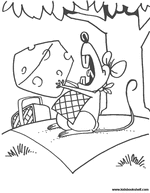How does it taste around the holes?
There is a marked difference in the expectations of German, French and Italian consumers regarding Emmentaler cheese.
Emmentaler is a traditional German cheese product, and is Germany's second most exported cheese. Italian and French consumers are especially fond of this famous holey hard. More Emmentaler is imported to France and too Italy than to any other country in Europe. However, not all Emmentalers are the same. The cheese can vary widely in its appearance, consistency, taste, and smell. For exporters, the question is which variety will find the most acceptance.
Is it possible to offer a uniform product in all the European export countries, or do consumers in the various countries prefer different sensory qualities in their cheese? This question was examined in a basic study conducted by the ESN member ASAP (Association for Sensory Analysis and Product Development) in Munich, a subsidiary of SAM Sensory and Marketing International AG, Switzerland, at the request of the external affairs department of the German Central Marketing Society of the Agricultural Economy, CMA.
In a first step a descriptive panel came up with differentiated taste profiles of 10 characteristic Emmentaler variations. The trained consumers found 42 terms to describe the cheese's sensory characteristics – colour, consistency, aroma, flavour, feeling in the mouth, and aftertaste. Approximately 300 Emmentaler consumers in France, Italy, and Germany tasted the samples under constant test conditions. They did not receive any information about brand or producer, and judged each characteristic on a 9-point-scale that ranged from pleasant to unpleasant. Additionally the test subjects answered questions about their shopping behaviour, eating habits, cost consciousness, and other relevant aspects.
The comparison of the taste profiles with the consumer judgements showed both general agreement and particular marked differences between the markets.
In all three countries Emmentaler varieties which were moderately yellow in colour and had a moderately fatty consistency were preferred. The test subjects generally concluded the cheese should not have a sour or fatty smell and should have a creamy melt-in-your-mouth feel.
- German consumers generally wanted a cheese with a milky-buttery taste, one that did not remind them of mealy potatoes or fat.
- French testers preferred a fruity-tasting cheese which evoked a glutinous or sticky sensation in the mouth
- Italians' favourite Emmentaler might also cause a sticky mouth feel, but should have an intense, even bitter aftertaste.
German consumers liked Emmentaler best. They thought it was important that the cheese had large holes, while the French people generally expected Emmentaler to have a lot of holes, not necessarily big ones. Italian consumers judged the varieties in a more differentiated manner than French consumers. Their preferred Emmentaler variety also differed from the German and the French testers' choices.
Even if the order of the rankings differed in the three countries, there was a general agreement with regard to the best and worst cheeses. These groups consisted of the same products in all three countries. Three of the tested varieties came very close to the calculated "ideal taste profile" for the three countries. The profiles of the other varieties differed to some degree from the ideal profile.
Source:
SAM ASAP GmbH, Munich, Germany
Dr. Martin Kern
For additional information, digital picture files or a sample copy please contact the ESN press office.
